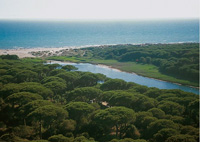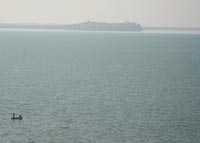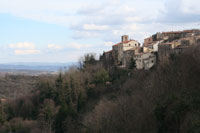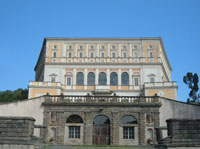 |
Raphael, View of the Stanza della Segnatura, Palazzi Pontifici, Vatican |
Stanze in the Palazzi Pontifici, Vatican |
| The Raphael Rooms (also called the Raphael Stanze) in the Palace of the Vatican are papal apartments with frescoes painted by Raphael. The Rooms were originally intended as a suite of apartments for Pope Julius II. He commissioned the relatively young artist Raffaello Sanzio and his studio in 1508 or 1509 to repaint the existing interiors of the rooms entirely. It was possibly Julius' intent to outshine the apartments of his predecessor (and rival) Pope Alexander VI as the Raphael Rooms are directly above Alexander's Borgia Apartment. The Raphael Stanze are on the third floor, overlooking the south side of the Belvedere Courtyard. Running from East to West, the rooms are called: The Hall of Constantine, The Room of the Heliodorus, The Room of the Segnatura and the Room of the Fire of the Borgo. The largest of the four rooms is the Hall of Constantine. Its paintings were not begun until Pope Julius and indeed, Raphael himself had died. The room is dedicated to the victory of Christianity over paganism. Its frescos depict this struggle from the life of the Roman Emperor Constantine. The fresco The Vision of Constantine depicts the legendary story of a cross appearing to Constantine as he marched to confront his rival Maxentius. In the vision he saw a great cross in the sky with the words "In Hoc Signo Vinces" (in this sign, conquer). The Battle of the Milvian Bridge shows the outcome of that contest. Also are the Baptism of Constantine on his deathbed, and the Donation of Constantine the presentation of a document allegedly granting the popes sovereignty over their territorial dominions. The artists were students of Raphael, Giulio Romano, Giovanni Francesco Penni and Raffaellino del Colle Because they are not by the master himself, the frescos are often less famous than works in the neighboring rooms. Continuing a long tradition of flattery, Raphael's apprentices gave the features of the current pontiff, Clement VII, to Pope Sylvester in the paintings. The next room, going from East to West, is the Room of the Heliodorus. It takes its name from one of the paintings. The theme of this private chamber was the heavenly protection granted by Christ to the Church. The four paintings are The Expulsion of Heliodorus from the Temple, The Meeting of Leo I and Attila, The Mass at Bolsena and The Liberation of St. Peter. The Expulsion recounts an event from the Book of II Maccabees where the thief, Heliodorus was trampled by horses while trying to steal the treasure of the Temple in Jerusalem. The Meeting of Leo and Attila depicts the storied parley between the Pope and the Hun conqueror, and includes the legendary images of Saints Peter and Paul in the sky bearing swords. The Mass at Bolsena depicts the story of a Bohemian priest in 1263 who ceased to doubt the doctrine of Transubstantiation when he saw the bread begin to bleed during its consecration at Mass. The Liberation of St. Peter shows a story from chapter twelve of the Book of Acts of an angel setting Peter free from prison. In all these paintings, Raphael flatteringly includes his patron, Pope Julius as participant or an observer. The theme of the Room of the Segnatura is worldly and spiritual wisdom and the harmony which Renaissance humanists perceived between Christian teaching and Greek philosophy. The theme of wisdom is appropriate as this room is a council chamber for the Apostolic Segnatura, where most of the important papal documents were signed and sealed. Two famous paintings are in this room: The School of Athens (representing worldly learning) and the Dispute over the Holy Sacrament (representing the church assembled in majesty). The other two frescos are Parnassus and another fresco divided into three sections. Above the window, in a lunette, is The Cardinal Virtues and beside the windows are Tribonian Consigns the Pandects to Emperor Justinian, and on the other side Pope Gregory IX Approves the Decretials. Raphael, as noted above was famous for depicting illustrious figures of the past with the features of his contemporaries. School of Athens is perhaps the most extended study in this. * Plato - holding the Timaeus - Pointing up as a sign of his metaphysical belief in the higher world of the forms, shown with the face of Leonardo. This room was named for Fire of the Borgo which depicts Pope Leo IV making the sign of the cross to extinguish a raging fire in the Borgo district of Rome near the Vatican. This room was prepared as a music room for Julius' successor, Leo X. The frescos depict events from the lives of Popes Leo III and Leo IV. The other paintings in the room are The Coronation of Charlemagne by Leo III, The Oath of Leo III before Charlemagne and The Naval Victory of Leo IV over the Sacracens at Ostia Though the Incident of the Borgo was based on Raphael's mature designs it was executed by his assistants, who painted the other thee paintings without his guidance. |
| The Fire in the Borgo (from the Stanza dell'Incendio di Borgo) |
[1] Modern criticism follows Morelli in supposing that Raphael painted Bazzi's portrait in The School of Athens. |
 |
||||
|
||||
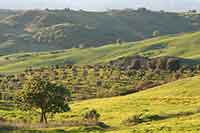 |
||||
Podere Santa Pia |
Pienza and the Val d'Orcia |
Century-old olive trees, between Podere Santa Pia and Cinigiano |
||
Marina di Grosseto |
Lago Trasimeno |
Scansano |
||
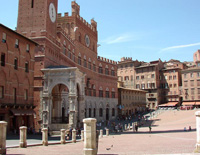 |
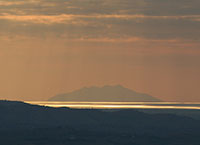 |
|||
Farnese |
Siena, Palazzo Publicco |
Sunsets in Tuscany |
||
 |
||||
| Podere Santa Pia, a dignified and spacious holiday house located on a spectacular, private and tranquil hillside, offering splendid views up to the Tyrrhenian coast and Monte Christo |
||||



